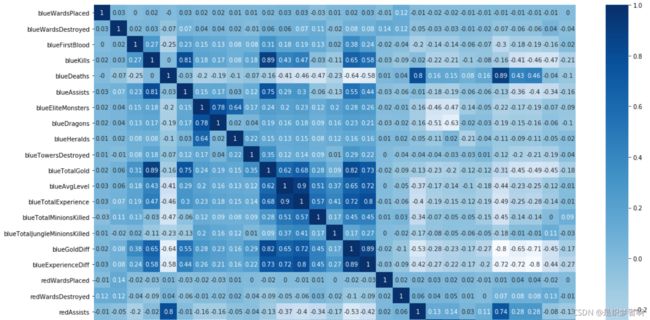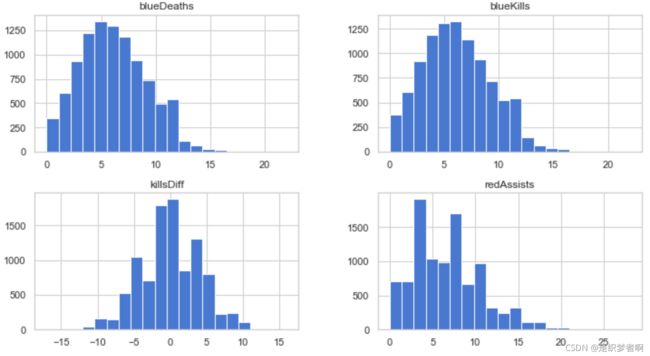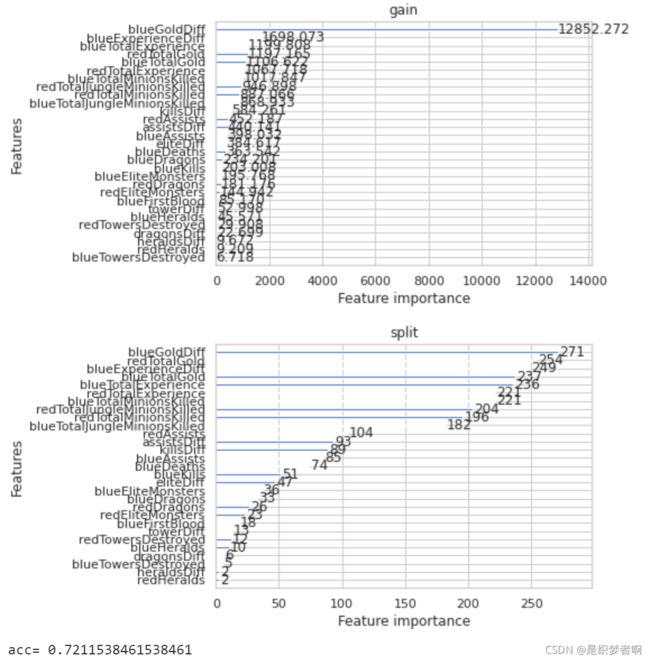机器学习训练营-基于LightGBM的分类预测学习笔记
文章目录
- 前言
- 一、学习知识点概要
- 二、学习内容
-
- 2.1 LightGBM的应用及优缺点
-
- 2.1.1 LightGBM的应用
- 2.1.2 LightGBM的优缺点
- 2.2 基于英雄联盟数据集的LightGBM分类实战
-
- Step1:下载数据集,导入库函数
- Step2:数据读取/载入
- Step3:数据信息简单查看
- Step4:可视化描述
- Step5:利用 LightGBM 进行训练与预测
- Step6: 利用 LightGBM 进行特征选择
- Step7: 通过调整参数获得更好的效果
- 三、学习问题与解答
-
- 3.1 drop函数的应用
- 3.2 如何看直方图中的数据分布差别
- 3.3 直方图和柱形图的区别
- 3.4 特征选择的方法
- 四、学习思考与总结
前言
本学习笔记为阿里云天池龙珠计划机器学习训练营的学习内容,学习链接为:
https://tianchi.aliyun.com/specials/promotion/aicampml
一、学习知识点概要
- 了解LightGBM的应用及优缺点
- 掌握 LightGBM的Python调用并将其运用到英雄联盟游戏胜负预测数据集上
二、学习内容
2.1 LightGBM的应用及优缺点
2.1.1 LightGBM的应用
LightGBM(Light Gradient Boosting Machine)是2017年由微软推出的可扩展机器学习系统,是微软旗下DMKT的一个开源项目,由2014年首届阿里巴巴大数据竞赛获胜者之一柯国霖老师带领开发。它是一款基于GBDT(梯度提升决策树,Gradient Boosting Decision Tree)算法的分布式梯度提升框架,为了满足缩短模型计算时间的需求,LightGBM的设计思路主要集中在减小数据对内存与计算性能的使用,以及减少多机器并行计算时的通讯代价。
LightGBM可以看作是XGBoost的升级豪华版,在获得与XGBoost近似精度的同时,又提供了更快的训练速度与更少的内存消耗。正如其名字中的Light所蕴含的那样,LightGBM在大规模数据集上跑起来更加优雅轻盈,一经推出便成为各种数据竞赛中刷榜夺冠的神兵利器。
LightGBM可应用于金融风控、购买行为识别、交通流量预测、环境声音分类、基因分类、生物成分分析等诸多领域。
2.1.2 LightGBM的优缺点
LightGBM的主要优点:
- 简单易用。提供了主流的Python\C++\R语言接口,用户可以轻松使用LightGBM建模并获得相当不错的效果。
- 高效可扩展。在处理大规模数据集时高效迅速、高准确度,对内存等硬件资源要求不高。
- 鲁棒性强。相较于深度学习模型不需要精细调参便能取得近似的效果。
- LightGBM直接支持缺失值与类别特征,无需对数据额外进行特殊处理
LightGBM的主要缺点:
- 相对于深度学习模型无法对时空位置建模,不能很好地捕获图像、语音、文本等高维数据。
- 在拥有海量训练数据,并能找到合适的深度学习模型时,深度学习的精度可以遥遥领先LightGBM。
2.2 基于英雄联盟数据集的LightGBM分类实战
Step1:下载数据集,导入库函数
#下载需要用到的数据集
!wget https://tianchi-media.oss-cn-beijing.aliyuncs.com/DSW/8LightGBM/high_diamond_ranked_10min.csv
## 基础函数库
import numpy as np
import pandas as pd
## 绘图函数库
import matplotlib.pyplot as plt
import seaborn as sns
现在共有9881场英雄联盟韩服钻石段位以上的排位比赛数据,数据提供了在十分钟时的游戏状态,包括击杀数、死亡数、金币数量、经验值、等级……等信息。列blueWins是数据的标签,代表了本场比赛是否为蓝队获胜。
数据的各个特征描述如下:
| 特征名称 | 特征意义 | 取值范围 |
|---|---|---|
| WardsPlaced | 插眼数量 | 整数 |
| WardsDestroyed | 拆眼数量 | 整数 |
| FirstBlood | 是否获得首次击杀 | 整数 |
| Kills | 击杀英雄数量 | 整数 |
| Deaths | 死亡数量 | 整数 |
| Assists | 助攻数量 | 整数 |
| EliteMonsters | 击杀大型野怪数量 | 整数 |
| Dragons | 击杀史诗野怪数量 | 整数 |
| Heralds | 击杀峡谷先锋数量 | 整数 |
| TowersDestroyed | 推塔数量 | 整数 |
| TotalGold | 总经济 | 整数 |
| AvgLevel | 平均英雄等级 | 浮点数 |
| TotalExperience | 英雄总经验 | 整数 |
| TotalMinionsKilled | 英雄补兵数量 | 整数 |
| TotalJungleMinionsKilled | 英雄击杀野怪数量 | 整数 |
| GoldDiff | 经济差距 | 整数 |
| ExperienceDiff | 经验差距 | 整数 |
| CSPerMin | 分均补刀 | 浮点数 |
| GoldPerMin | 分均经济 | 浮点数 |
Step2:数据读取/载入
## 我们利用Pandas自带的read_csv函数读取并转化为DataFrame格式
df = pd.read_csv('./high_diamond_ranked_10min.csv')
y = df.blueWins
#列**blueWins**是数据的标签,代表了本场比赛是否为蓝队获胜。
Step3:数据信息简单查看
## 利用.info()查看数据的整体信息
df.info()
运行结果
RangeIndex: 9879 entries, 0 to 9878
Data columns (total 40 columns):
# Column Non-Null Count Dtype
--- ------ -------------- -----
0 gameId 9879 non-null int64
1 blueWins 9879 non-null int64
2 blueWardsPlaced 9879 non-null int64
3 blueWardsDestroyed 9879 non-null int64
4 blueFirstBlood 9879 non-null int64
5 blueKills 9879 non-null int64
6 blueDeaths 9879 non-null int64
7 blueAssists 9879 non-null int64
8 blueEliteMonsters 9879 non-null int64
9 blueDragons 9879 non-null int64
10 blueHeralds 9879 non-null int64
11 blueTowersDestroyed 9879 non-null int64
12 blueTotalGold 9879 non-null int64
13 blueAvgLevel 9879 non-null float64
14 blueTotalExperience 9879 non-null int64
15 blueTotalMinionsKilled 9879 non-null int64
16 blueTotalJungleMinionsKilled 9879 non-null int64
17 blueGoldDiff 9879 non-null int64
18 blueExperienceDiff 9879 non-null int64
19 blueCSPerMin 9879 non-null float64
20 blueGoldPerMin 9879 non-null float64
21 redWardsPlaced 9879 non-null int64
22 redWardsDestroyed 9879 non-null int64
23 redFirstBlood 9879 non-null int64
24 redKills 9879 non-null int64
25 redDeaths 9879 non-null int64
26 redAssists 9879 non-null int64
27 redEliteMonsters 9879 non-null int64
28 redDragons 9879 non-null int64
29 redHeralds 9879 non-null int64
30 redTowersDestroyed 9879 non-null int64
31 redTotalGold 9879 non-null int64
32 redAvgLevel 9879 non-null float64
33 redTotalExperience 9879 non-null int64
34 redTotalMinionsKilled 9879 non-null int64
35 redTotalJungleMinionsKilled 9879 non-null int64
36 redGoldDiff 9879 non-null int64
37 redExperienceDiff 9879 non-null int64
38 redCSPerMin 9879 non-null float64
39 redGoldPerMin 9879 non-null float64
dtypes: float64(6), int64(34)
memory usage: 3.0 MB
## 进行简单的数据查看,我们可以利用 .head() 头部.tail()尾部
df.head()
df.tail()
## 标注标签并利用value_counts函数查看训练集标签的数量
y = df.blueWins
y.value_counts()
结果:
0 4949
,1 4930
,Name: blueWins, dtype: int64
数据集正负标签数量基本相同,不存在数据不平衡的问题。
## 标注特征列
drop_cols = ['gameId','blueWins']
x = df.drop(drop_cols, axis=1)
## 对于特征进行一些统计描述
x.describe()
- 我们发现不同对局中插眼数和拆眼数的取值范围存在明显差距,甚至有前十分钟插了250个眼的异常值。
- 我们发现EliteMonsters的取值相当于Deagons + Heralds。
- 我们发现TotalGold 等变量在大部分对局中差距不大。
- 我们发现两支队伍的经济差和经验差是相反数。
- 我们发现红队和蓝队拿到首次击杀的概率大概都是50%
## 根据上面的描述,我们可以去除一些重复变量,比如只要知道蓝队是否拿到一血,我们就知道红队有没有拿到,可以去除红队的相关冗余数据。
drop_cols = ['redFirstBlood','redKills','redDeaths'
,'redGoldDiff','redExperienceDiff', 'blueCSPerMin',
'blueGoldPerMin','redCSPerMin','redGoldPerMin']
x.drop(drop_cols, axis=1, inplace=True)
Step4:可视化描述
data = x
data_std = (data - data.mean()) / data.std()
data = pd.concat([y, data_std.iloc[:, 0:9]], axis=1)
data = pd.melt(data, id_vars='blueWins', var_name='Features', value_name='Values')
fig, ax = plt.subplots(1,2,figsize=(15,5))
# 绘制小提琴图
sns.violinplot(x='Features', y='Values', hue='blueWins', data=data, split=True,
inner='quart', ax=ax[0], palette='Blues')
fig.autofmt_xdate(rotation=45)
data = x
data_std = (data - data.mean()) / data.std()
data = pd.concat([y, data_std.iloc[:, 9:18]], axis=1)
data = pd.melt(data, id_vars='blueWins', var_name='Features', value_name='Values')
# 绘制小提琴图
sns.violinplot(x='Features', y='Values', hue='blueWins',
data=data, split=True, inner='quart', ax=ax[1], palette='Blues')
fig.autofmt_xdate(rotation=45)
plt.show()

**小提琴图 (Violin Plot)**是用来展示多组数据的分布状态以及概率密度。这种图表结合了箱形图和密度图的特征,主要用来显示数据的分布形状。
从图中我们可以看出:
- 击杀英雄数量越多更容易赢,死亡数量越多越容易输(bluekills与bluedeaths左右的区别)。
- 助攻数量与击杀英雄数量形成的图形状类似,说明他们对游戏结果的影响差不多。 一血的取得情况与获胜有正相关,但是相关性不如击杀英雄数量明显。
- 经济差与经验差对于游戏胜负的影响较大。 击杀野怪数量对游戏胜负的影响并不大。
plt.figure(figsize=(18,14))
sns.heatmap(round(x.corr(),2), cmap='Blues', annot=True)
plt.show()


同时我们画出各个特征之间的相关性热力图,颜色越深代表特征之间相关性越强,我们剔除那些相关性较强的冗余特征。
# 去除冗余特征
drop_cols = ['redAvgLevel','blueAvgLevel']
x.drop(drop_cols, axis=1, inplace=True)
sns.set(style='whitegrid', palette='muted')
# 构造两个新特征
x['wardsPlacedDiff'] = x['blueWardsPlaced'] - x['redWardsPlaced']
x['wardsDestroyedDiff'] = x['blueWardsDestroyed'] - x['redWardsDestroyed']
data = x[['blueWardsPlaced','blueWardsDestroyed','wardsPlacedDiff','wardsDestroyedDiff']].sample(1000)
data_std = (data - data.mean()) / data.std()
data = pd.concat([y, data_std], axis=1)
data = pd.melt(data, id_vars='blueWins', var_name='Features', value_name='Values')
plt.figure(figsize=(10,6))
sns.swarmplot(x='Features', y='Values', hue='blueWins', data=data)
plt.xticks(rotation=45)
plt.show()

以上是插眼数量的散点图,发现不存在插眼数量与游戏胜负间的显著规律。猜测由于钻石分段以上在哪插眼在哪好排眼都是套路(这段话没太懂,毕竟不玩游戏,知道下一步是去除相关特特征就行了),所以数据中前十分钟插眼数拔眼数对游戏的影响不大。所以我们暂时先把这些特征去掉。
## 去除和眼位相关的特征
drop_cols = ['blueWardsPlaced','blueWardsDestroyed','wardsPlacedDiff',
'wardsDestroyedDiff','redWardsPlaced','redWardsDestroyed']
x.drop(drop_cols, axis=1, inplace=True)
x['killsDiff'] = x['blueKills'] - x['blueDeaths']
x['assistsDiff'] = x['blueAssists'] - x['redAssists']
x[['blueKills','blueDeaths','blueAssists','killsDiff','assistsDiff','redAssists']].hist(figsize=(12,10), bins=20)
plt.show()
我们发现击杀、死亡与助攻数的数据分布差别不大。但是击杀减去死亡、助攻减去死亡的分布与原分布差别很大,因此我们新构造这么两个特征。
解释:先给上面的图6个编号
这里说的是Kills(击杀)、Deaths(死亡)、Assists(助攻数),击杀减去死亡(第5个直方图)、助攻减去死亡(第1个直方图)
留两个问题:如何看直方图中的数据分布差别?直方图和柱形图的区别?
data = x[['blueKills','blueDeaths','blueAssists','killsDiff','assistsDiff','redAssists']].sample(1000)
data_std = (data - data.mean()) / data.std()
data = pd.concat([y, data_std], axis=1)
data = pd.melt(data, id_vars='blueWins', var_name='Features', value_name='Values')
plt.figure(figsize=(10,6))
sns.swarmplot(x='Features', y='Values', hue='blueWins', data=data)
plt.xticks(rotation=45)
plt.show()

从上图我们可以发现击杀数与死亡数与助攻数,以及我们构造的特征对数据都有较好的分类能力。
data = pd.concat([y, x], axis=1).sample(500)
sns.pairplot(data, vars=['blueKills','blueDeaths','blueAssists','killsDiff','assistsDiff','redAssists'],
hue='blueWins')
plt.show()
x['dragonsDiff'] = x['blueDragons'] - x['redDragons']
x['heraldsDiff'] = x['blueHeralds'] - x['redHeralds']
x['eliteDiff'] = x['blueEliteMonsters'] - x['redEliteMonsters']
data = pd.concat([y, x], axis=1)
eliteGroup = data.groupby(['eliteDiff'])['blueWins'].mean()
dragonGroup = data.groupby(['dragonsDiff'])['blueWins'].mean()
heraldGroup = data.groupby(['heraldsDiff'])['blueWins'].mean()
fig, ax = plt.subplots(1,3, figsize=(15,4))
eliteGroup.plot(kind='bar', ax=ax[0])
dragonGroup.plot(kind='bar', ax=ax[1])
heraldGroup.plot(kind='bar', ax=ax[2])
print(eliteGroup)
print(dragonGroup)
print(heraldGroup)
plt.show()
我们构造了两队之间是否拿到龙、是否拿到峡谷先锋、击杀大型野怪的数量差值,发现在游戏的前期拿到龙比拿到峡谷先锋更容易获得胜利。拿到大型野怪的数量和胜率也存在着强相关。
x['towerDiff'] = x['blueTowersDestroyed'] - x['redTowersDestroyed']
data = pd.concat([y, x], axis=1)
towerGroup = data.groupby(['towerDiff'])['blueWins']
print(towerGroup.count())
print(towerGroup.mean())
fig, ax = plt.subplots(1,2,figsize=(15,5))
towerGroup.mean().plot(kind='line', ax=ax[0])
ax[0].set_title('Proportion of Blue Wins')
ax[0].set_ylabel('Proportion')
towerGroup.count().plot(kind='line', ax=ax[1])
ax[1].set_title('Count of Towers Destroyed')
ax[1].set_ylabel('Count')


推塔是英雄联盟这个游戏的核心,因此推塔数量可能与游戏的胜负有很大关系。我们绘图发现,尽管前十分钟推掉第一座防御塔的概率很低,但是一旦某只队伍推掉第一座防御塔,获得游戏的胜率将大大增加。
Step5:利用 LightGBM 进行训练与预测
## 为了正确评估模型性能,将数据划分为训练集和测试集,并在训练集上训练模型,在测试集上验证模型性能。
from sklearn.model_selection import train_test_split
## 选择其类别为0和1的样本 (不包括类别为2的样本)
data_target_part = y
data_features_part = x
## 测试集大小为20%, 80%/20%分
x_train, x_test, y_train, y_test = train_test_split(data_features_part, data_target_part, test_size = 0.2, random_state = 2020)
## 导入LightGBM模型
from lightgbm.sklearn import LGBMClassifier
## 定义 LightGBM 模型
clf = LGBMClassifier()
# 在训练集上训练LightGBM模型
clf.fit(x_train, y_train)
上面这个代码块运行时间有点久。
LGBMClassifier(boosting_type='gbdt', class_weight=None, colsample_bytree=1.0,
importance_type='split', learning_rate=0.1, max_depth=-1,
min_child_samples=20, min_child_weight=0.001, min_split_gain=0.0,
n_estimators=100, n_jobs=-1, num_leaves=31, objective=None,
random_state=None, reg_alpha=0.0, reg_lambda=0.0, silent=True,
subsample=1.0, subsample_for_bin=200000, subsample_freq=0)
## 在训练集和测试集上分布利用训练好的模型进行预测
train_predict = clf.predict(x_train)
test_predict = clf.predict(x_test)
from sklearn import metrics
## 利用accuracy(准确度)【预测正确的样本数目占总预测样本数目的比例】评估模型效果
print('The accuracy of the Logistic Regression is:',metrics.accuracy_score(y_train,train_predict))
print('The accuracy of the Logistic Regression is:',metrics.accuracy_score(y_test,test_predict))
## 查看混淆矩阵 (预测值和真实值的各类情况统计矩阵)
confusion_matrix_result = metrics.confusion_matrix(test_predict,y_test)
print('The confusion matrix result:\n',confusion_matrix_result)
# 利用热力图对于结果进行可视化
plt.figure(figsize=(8, 6))
sns.heatmap(confusion_matrix_result, annot=True, cmap='Blues')
plt.xlabel('Predicted labels')
plt.ylabel('True labels')
plt.show()
我们可以发现共有718 + 707个样本预测正确,306 + 245个样本预测错误。
Step6: 利用 LightGBM 进行特征选择
LightGBM的特征选择属于特征选择中的嵌入式方法,在LightGBM中可以用属性feature_importances_去查看特征的重要度。
sns.barplot(y=data_features_part.columns, x=clf.feature_importances_)
总经济差距等特征,助攻数量、击杀死亡数量等特征都具有很大的作用。插眼数、推塔数对模型的影响并不大。
除此之外,我们还可以使用LightGBM中的下列重要属性来评估特征的重要性。
- gain:当利用特征做划分的时候的评价基尼指数
- split:是以特征用到的次数来评价
from sklearn.metrics import accuracy_score
from lightgbm import plot_importance
def estimate(model,data):
#sns.barplot(data.columns,model.feature_importances_)
ax1=plot_importance(model,importance_type="gain")
ax1.set_title('gain')
ax2=plot_importance(model, importance_type="split")
ax2.set_title('split')
plt.show()
def classes(data,label,test):
model=LGBMClassifier()
model.fit(data,label)
ans=model.predict(test)
estimate(model, data)
return ans
ans=classes(x_train,y_train,x_test)
pre=accuracy_score(y_test, ans)
print('acc=',accuracy_score(y_test,ans))
Step7: 通过调整参数获得更好的效果
LightGBM中包括但不限于下列对模型影响较大的参数:
- learning_rate: 有时也叫作eta,系统默认值为0.3。每一步迭代的步长,很重要。太大了运行准确率不高,太小了运行速度慢。
- num_leaves:系统默认为32。这个参数控制每棵树中最大叶子节点数量。
- feature_fraction:系统默认值为1。我们一般设置成0.8左右。用来控制每棵随机采样的列数的占比(每一列是一个特征)。
- max_depth: 系统默认值为6,我们常用3-10之间的数字。这个值为树的最大深度。这个值是用来控制过拟合的。max_depth越大,模型学习的更加具体。
调节模型参数的方法有贪心算法、网格调参、贝叶斯调参等。这里我们采用网格调参,它的基本思想是穷举搜索:在所有候选的参数选择中,通过循环遍历,尝试每一种可能性,表现最好的参数就是最终的结果
## 从sklearn库中导入网格调参函数
from sklearn.model_selection import GridSearchCV
## 定义参数取值范围
learning_rate = [0.1, 0.3, 0.6]
feature_fraction = [0.5, 0.8, 1]
num_leaves = [16, 32, 64]
max_depth = [-1,3,5,8]
parameters = { 'learning_rate': learning_rate,
'feature_fraction':feature_fraction,
'num_leaves': num_leaves,
'max_depth': max_depth}
model = LGBMClassifier(n_estimators = 50)
## 进行网格搜索
clf = GridSearchCV(model, parameters, cv=3, scoring='accuracy',verbose=3, n_jobs=-1)
clf = clf.fit(x_train, y_train)
## 网格搜索后的最好参数为
clf.best_params_
## 在训练集和测试集上分布利用最好的模型参数进行预测
## 定义带参数的 LightGBM模型
clf = LGBMClassifier(feature_fraction = 0.8,
learning_rate = 0.1,
max_depth= 3,
num_leaves = 16)
# 在训练集上训练LightGBM模型
clf.fit(x_train, y_train)
train_predict = clf.predict(x_train)
test_predict = clf.predict(x_test)
## 利用accuracy(准确度)【预测正确的样本数目占总预测样本数目的比例】评估模型效果
print('The accuracy of the Logistic Regression is:',metrics.accuracy_score(y_train,train_predict))
print('The accuracy of the Logistic Regression is:',metrics.accuracy_score(y_test,test_predict))
## 查看混淆矩阵 (预测值和真实值的各类情况统计矩阵)
confusion_matrix_result = metrics.confusion_matrix(test_predict,y_test)
print('The confusion matrix result:\n',confusion_matrix_result)
# 利用热力图对于结果进行可视化
plt.figure(figsize=(8, 6))
sns.heatmap(confusion_matrix_result, annot=True, cmap='Blues')
plt.xlabel('Predicted labels')
plt.ylabel('True labels')
plt.show()
原本有306 + 245个错误,现在有 287 + 230个错误,带来了明显的正确率提升。
三、学习问题与解答
3.1 drop函数的应用
函数定义:DataFrame.drop(labels=None,axis=0, index=None, columns=None, inplace=False)
删除单个行
- axis=0,指删除index,因此删除columns时要指定axis=1
- inplace :布尔类型,默认值为false。采用inplace=True之后,原数组名对应的内存值直接改变。
教程中使用列表删除多列,如下:
drop_cols = ['blueWardsPlaced','blueWardsDestroyed','wardsPlacedDiff',
'wardsDestroyedDiff','redWardsPlaced','redWardsDestroyed']
x.drop(drop_cols, axis=1, inplace=True)
3.2 如何看直方图中的数据分布差别
直方图的使用场景
直方图一般在初步研究中使用,对数据分布特征进行描述。以及在判断数据正态性时,可作为初步判断工具。

通过直方图可以得到以下信息:
(1)显示数据波动及分布情况,有无离群值等
(2)显示数据正态性
正态曲线基本对称,且呈“钟形”分布,说明数据基本满足正态分布。
参考资料:直方图、正态图,如何解读才正确?
3.3 直方图和柱形图的区别
3.4 特征选择的方法
- Filter:过滤法,按照发散性或者相关性对各个特征进行评分,设定阈值或者待选择阈值的个数,选择特征。
- Wrapper:包装法,根据目标函数(通常是预测效果评分),每次选择若干特征,或者排除若干特征。
- Embedded:嵌入法,先使用某些机器学习的算法和模型进行训练,得到各个特征的权值系数,根据系数从大到小选择特征。类似于Filter方法,但是是通过训练来确定特征的优劣。
四、学习思考与总结
至此,机器学习训练营告一段落了,已经学完了逻辑回归、XGBoost以及LightGBM的应用,下一步还需学习特征选择和调参方法。














